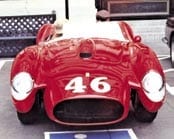Before attempting to delineate the best seven-figure Ferraris, I called multiple collectors, dealers and historians for their feedback, and I must admit to being surprised at how varied the opinions were. Of course, I had my own ideas on the subject, but it was made clear from my conversations that when you’ve got deep, deep pockets, you’ve got many, many choices. While there was little overall consensus among those I surveyed, some favorites emerged.
BEST EVENT CAR
The 250 Testa Rossa (1956–61) is eligible for literally every event on the planet, from the Roman roadways of the Mille Miglia to the highways of the Colorado Grand to the lawn at Pebble Beach. When vintage raced, TRs are reasonably competitive, running at the front in Ferrari-only races and near the front in multi-marque competitions.
The 250 TR perfectly captures the look of the late 1950s sports racer with its swoopy lines and sexy pontoon fenders. Even better, TRs are robust, don’t break, and parts are available. A TR is a very forgiving car to drive, giving lots of feedback and helping to make a bad driver look good and a good driver look busy.
The price to be in the game? Over $10m.
BEST INVESTMENT
While my crystal ball was recalled for defects around 1991, I still opine that a 250 GTO (1962–64) is a pretty safe investment today. While they have now hit their former 1989 peak prices, these values are still low when you factor in inflation. If stock market and interest rate uncertainties continue, owning a GTO certainly seems prudent compared to owning several million shares of any number of publicly traded companies whose self-serving managers make used-car dealers look like philanthropists.
Ferrari GTO ownership also guarantees you an invitation to almost any event, competition, or concours. It means you are a top player in the world of collector cars, and have the trophy in your garage to prove it. Besides, GTOs rarely sit alone in a one-car garage, with virtually every owner’s car serving as the centerpiece of a substantial Ferrari collection.
The price to park one in your garage? Don’t expect any change from today’s $12–$13m for a no-stories car.
BEST SERIOUS VINTAGE RACER
Okay, I’ll admit it, my choice for the ultimate hot ride combined with the ultimate sound are the 1970 512 S and the 1971 512 M. They were built to run flat-out for 24 hours at Le Mans, and are very durable and almost never break in today’s 30-minute vintage races. With a factory rating of 600 hp and weighing only 1,800 pounds, their performance is staggering.
Before today’s chicanes were installed at Le Mans, the 3.5-mile Mulsanne Straight was the fastest piece of racing real estate in the world, and 512 drivers shifted from fourth to fifth at 195 mph on the way to a 218 mph top speed. Not for the timid or those with limited racing experience, when set up properly, a 512 is a joy to drive with massive torque, a power curve that seems to go on forever and tolerable brakes.
The price to win the Ferrari-Maserati Historic series? Under $2m.
BEST FIRST FERRARI RACER
In theory, the 250 Tour de France (1956–59) was available new to anyone with the ability to write a check to the local Ferrari dealer for $12,000. In fact, the best cars with the latest camshafts, pistons and lightweight parts were reserved for the best-known, most talented and well-connected drivers. Even so, a mildly tuned TdF was more than adequate to run away from virtually any competitor of its time, including Corvettes, 300SLs and Jaguar XK 140s.
Nothing has changed in the last five decades, and the 250 TdF is still a great race car that rewards the skillful without punishing those of lesser talents. The soft suspension, skinny tires, live rear axle and light weight give great driver feedback and make for a great event car, race car, and even user-friendly weekend street car.
The price to get started? About $1.5m and up.
BEST ALL-AROUND BUY
The 1966 275 GTB/C is one of the lesser known Ferraris, often overshadowed by its predecessors, the 250 GT SWB and 250 GTO. As Ferrari’s last purpose-built GT-racer, the 275 GTB/C is a true race car that is the rightful successor to Ferrari’s 250 GTO. Faster and more technically advanced than the GTO, the 275 GTB/C is also rarer, with only 12 produced versus 36 GTOs.
Ferrari built these cars between the end of the 275 GTB production run and the start of the 275 GTB/4 run, all of them fitted with a lightweight frame and body, powered by a three-carb, dry-sump 250 LM engine. The 275’s tipo 213 engine was mistakenly homologated with three rather than six carbs, so this paperwork blunder was resolved by using three Weber 40 DF13 carburetors that gave over 300 hp at 7500 rpm. These were the last competition GT cars designed and built from the ground up by Forghieri and the racing department at Maranello.
The price for this durable vintage racer? A great bang-for-the-buck at just under $1.5m.
WHERE DO WE GO FROM HERE?
All of these cars have now reached their 1989 high-water mark, but this is thankfully not because of a rush of speculators with too much money and too short a memory jumping on the bandwagon. Unlike the late 1980s, the Ferrari world of today is not one of Dutch tulip mania.
Vintage Ferraris are being bought by real people, with real money, and for real purposes. As this list shows, eligibility for events creates value, and there is a great deal of money out there willing to step up for personal satisfaction and entertainment. It’s taken 15 years, but the Ferrari market is now strong across the board. As long as appreciation continues to be gradual and not led by greed, expect the market to remain strong and stable.


